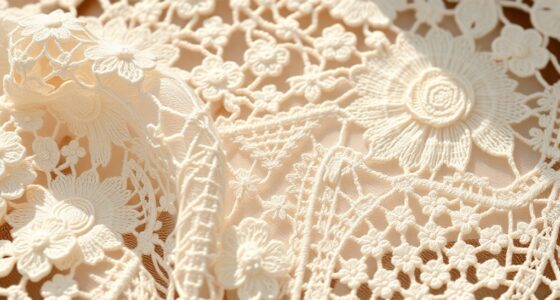Labyrinth designs hold deep symbolism, representing life’s journey, spiritual growth, and reflection. You might notice their intricate patterns used in art to evoke mystery and challenge, encouraging mindfulness and inner exploration. Their origins date back thousands of years, serving as tools for meditation and pilgrimage across cultures and religions. These timeless designs continue to inspire, embodying perseverance and the quest for meaning. Exploring their history and artistry reveals even more profound insights into their enduring significance.
Key Takeaways
- Labyrinth designs symbolize life’s journey, spiritual growth, and personal reflection, often used as tools for meditation and mindfulness in art.
- Historically, labyrinths originated in various cultures, including Greek and medieval Christian traditions, representing pilgrimage and spiritual quests.
- Artistic representations of labyrinths employ symmetrical patterns to evoke calm, focus, and metaphorical pathways toward enlightenment.
- They serve as powerful symbols of perseverance, inner exploration, and the human desire for order amid chaos.
- Contemporary art and spiritual practices incorporate labyrinth motifs to inspire reflection, growth, and the ongoing search for meaning.

Have you ever wondered what makes a labyrinth both intriguing and challenging? It’s the complex beauty of its design, often rooted in ancient symbolism and crafted to evoke reflection or spiritual journeys. At the heart of many labyrinths are meditative patterns, intricate pathways that guide your steps inward, encouraging contemplation and mindfulness. These patterns are more than just decorative; they serve as tools for meditation, helping you focus your mind and find a sense of calm amid chaos. The origins of these designs stretch back thousands of years, with their historical origins deeply embedded in various cultural and religious traditions. From the winding paths carved into ancient Greek and Roman mosaics to the stone labyrinths in medieval Europe, their purpose often extended beyond mere decoration, embodying spiritual quests or symbolic journeys toward enlightenment.
The historical origins of labyrinth designs reveal a fascinating evolution. In ancient Greece, labyrinths were famously associated with the myth of the Minotaur, symbolizing a complex maze that represented chaos and the journey toward order. These early designs were often geometric and symmetrical, emphasizing harmony and balance. As civilizations progressed, labyrinths took on different meanings, with the medieval Christian tradition adopting the shape as a symbolic pilgrimage path. These labyrinths, often embedded in cathedral floors, served as a spiritual exercise—walking the labyrinth mimicked a pilgrimage, guiding believers through a metaphorical journey of faith, repentance, and divine connection. Their intricate, looping paths were deliberately designed to engage the walker’s mind and soul, fostering introspection and spiritual growth.
In art, labyrinth designs symbolize more than just physical pathways; they represent life’s complex journey, personal growth, and the pursuit of inner truth. Artists utilize labyrinth motifs to evoke a sense of mystery, challenge, and the eternal quest for meaning. The meditative patterns within these designs often feature symmetrical, repetitive elements that draw the eye and encourage a calming, rhythmic focus. When incorporated into visual art, labyrinths invite viewers to reflect on their own life paths, emphasizing the idea that progress isn’t always linear and that challenges are part of the process. Whether used as a visual metaphor or a literal pathway, labyrinth designs serve as powerful symbols of perseverance, introspection, and the enduring human desire to find order within chaos. Their rich history and symbolic depth continue to inspire contemporary artists and spiritual seekers alike, making them timeless motifs in art and culture.
Frequently Asked Questions
How Do Labyrinth Designs Vary Across Different Cultures?
You’ll notice that labyrinth designs vary across cultures, reflecting different cultural interpretations. For example, Greek labyrinths often symbolize a journey or quest, while Celtic designs incorporate intricate knotwork representing eternity. In Asian cultures, labyrinth patterns might emphasize spiritual pathways or meditation routes. These design variations reveal unique beliefs and values, making each cultural interpretation distinct and meaningful in its own way.
What Are the Spiritual Benefits of Walking a Labyrinth?
Walking a labyrinth is like stepping into a sacred garden, offering you space for meditative reflection and spiritual healing. As you navigate its twists and turns, you quiet your mind and connect with your inner self. This mindful journey helps release stress, fosters clarity, and deepens your spiritual awareness. The rhythmic movement encourages a sense of peace and renewal, making it a powerful tool for nurturing your soul and finding balance.
How Do Architects Incorporate Labyrinth Symbolism Into Modern Buildings?
Architects incorporate labyrinth symbolism into modern buildings through architectural ornamentation and symbolic pathway design, creating spaces that invite exploration and reflection. You’ll notice intricate maze-like patterns in floor tiles, wall carvings, or garden layouts, which serve as visual metaphors for journey and introspection. These designs not only enhance aesthetics but also foster a sense of connection and mindfulness within the environment, blending tradition with contemporary architecture seamlessly.
Are There Specific Materials Traditionally Used in Labyrinth Construction?
You’ll find that traditional labyrinths often use durable materials like stone carving and medieval mosaic tiles. These materials not only guarantee longevity but also add intricate detail to the design. Stone carving creates textured, lasting paths, while medieval mosaics provide vibrant, patterned surfaces. When constructing labyrinths, choosing these materials helps preserve their symbolic meaning and aesthetic appeal, reflecting centuries of craftsmanship and spiritual significance.
How Has Digital Art Integrated Labyrinth Symbolism Historically?
Think of digital art as a mirror reflecting ancient mysteries; it seamlessly integrates labyrinth symbolism into modern contexts. You see virtual labyrinths created with digital symbolism that invite viewers to navigate complex, layered worlds. This evolution transforms traditional labyrinths into interactive experiences, blending history with technology. As a result, digital art preserves the symbolic power of labyrinths, encouraging exploration and self-discovery in innovative, virtual domains that expand their timeless significance.
Conclusion
As you explore labyrinth designs, remember they’re more than just intricate patterns—they’re journeys of self-discovery. Think of the myth of Theseus, traversing the labyrinth to defeat the Minotaur; your own path may be confusing, but perseverance leads to clarity. Just like that hero, you’ll find that every twist and turn in art and life helps reveal deeper meanings. Embrace the symbolism, and let each design guide you toward insight and growth.











